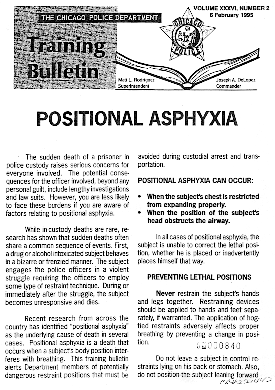

 |
 |

Published by The Chicago Reporter on its Web Site
[http://www.chicagoreporter.com/1999/03-99/0399position.htm]
in March of 1999, this Training Bulletin was actually released by
The Chicago Police Department in February, 1995.

THE CHICAGO POLICE DEPARTMENT
Training Bulletin
Volume XXXVI, Number 2
6 February 1995
raises serious concerns for everyone involved. The potential consequences for the officer involved, beyond any personal guilt, include lengthy investigations and law suits. However, you are less likely to face these burdens if you are aware of factors relating to positional asphyxia.
While in-custody deaths are rare, research has |
 |
Recent research from across the country has identified "positional asphyxia" as the underlying cause of death in several cases. Positional asphyxia is a death that occurs when a subject's body position interferes with breathing. This training bulletin alerts Department members of potentially dangerous restraint positions that must be avoided during custodial arrest and transportation.
Positional Asphyxia Can Occur:
In all cases of positional asphyxia, the subject is unable to correct the lethal position, whether he is placed or inadvertently places himself that way.
Preventing Lethal Positions:
Never restrain the subject's hands and legs together. Restraining devices should only be applied to hands and feet separately, if warranted. The application of hog-tied restraints adversely affects proper breathing by preventing a change in position.
Do not leave a subject in control restraints lying on his back or stomach. Also do not position the subject leaning forward in a sitting position with hands and legs restrained together. These positions can also contribute to obstruction of the airway, thereby resulting in positional asphyxia.
Do not put weight on an arrestee's back, such as with your knee, for a prolonged period. This practice adds stress to the respiratory muscles and inhibits movement of the diaphragm and rib cage.
Furthermore, do not keep the arrestee waiting for transportation in a restrained position without being properly monitored. Monitor the prisoner by watching the three ABCs: Airway, Breathing and Circulation.
Note: The subject's ability to speak without difficulty
indicates that the airway is open, and breathing and circulation are present.
[CHAS' NOTE: This is SOOOOO WRONG!!!! This false assumption is the cornerstone of many Restraint Asphyxia deaths while in the "custody" of medically-trained personnel. (And, it is a fallacy that still continues to be taught in medical programs!) The only thing that "noise production" ("speech") indicates is that the subject is able to move a snippet of air past his vocal cords. It indicates an "open airway." But, it does NOT indicate that "breathing" is adequate, or that it will continue!]
Contributing Factors:
Many factors contribute to a victim's susceptibility to positional asphyxia. There is an increased risk for positional asphyxia if one or more of the following indicators are present.
Conclusion:
When feasible, officers should handcuff an arrestee with both hands behind his back and palms positioned outward. Because of the possibility of positional asphyxia, hog-tying of a subject must always be avoided. If temporary prone positioning is required for control, the subject must be closely and constantly monitored. Officers should be aware of any obvious physical disabilities, mental state, or the possibility the subject is under the influence of alcohol or narcotics.
Although most officers have no reason to expect death to result from restraining a subject, the possibility exist. By exercising caution and common sense, the potential for in-custody deaths from positional asphyxia will be lessened.

Written By: Research & Analysis and Physical Training Units, Training Division
Information Taken From:
Science and Technology, International Association of Chiefs of Police, "Pepper Spray and In-Custody Deaths" by John Granfield, Jami Onnen and Charles S. Petty, MD;
The American Journal of Forensic Medicine and Pathology; "Restraint Asphyxiation in Exited Delirium" by Ronald L. O'Halloran, M.D., and Larry V. Lewman, M.D. "Position Asphyxiation in Adults" by Michael D. Bell, M.D., Valerie J. Rao, M.D. Charles V. Wetti, M.D. and Richard N. Rodriguez, B.A., "Positional Asphyxia During Law Enforcement Transport" by Donald T. Reay, M.D., Corinne L. Flinger, M.D., Allan D. Stilwell, M.D. and Judy Arnold
Source: The Chicago Police Department.


 Email Charly at: c-d-miller@neb.rr.com
Email Charly at: c-d-miller@neb.rr.com